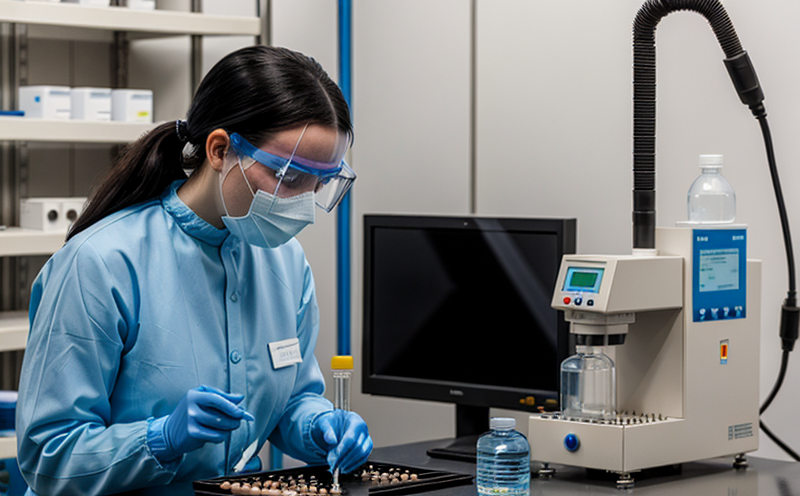Nickel Impurity Profiling Testing
In the pharmaceutical industry, ensuring product purity is paramount. Nickel impurities are a critical concern due to their potential impact on drug stability and safety. This service focuses on nickel impurity profiling using advanced analytical techniques that provide precise quantification of nickel in various pharmaceutical formulations.
The testing process involves several key steps: sample preparation, which includes dissolving or extracting the nickel from the formulation; instrumental analysis using Inductively Coupled Plasma Mass Spectrometry (ICP-MS) and High-Performance Liquid Chromatography (HPLC), both of which are highly sensitive and accurate methods for detecting trace amounts of metals like nickel.
The service is designed to meet stringent pharmaceutical industry standards, including those set by the United States Pharmacopeia (USP) and European Pharmacopoeia (EP). The testing ensures that the presence of nickel does not exceed acceptable limits as defined in these pharmacopeias. This is crucial for maintaining product quality and patient safety.
The methodology used in this service aligns with international standards such as ISO 17025, which sets criteria for technical competence in calibration and testing laboratories. The use of ICP-MS allows for the detection of nickel down to parts per billion (ppb) levels, ensuring that even trace amounts are not overlooked.
The service provides detailed reports that include comprehensive data on nickel content, along with recommendations for any necessary corrective actions if impurity levels exceed acceptable limits. This ensures that pharmaceutical companies can meet regulatory requirements and maintain product integrity.
| Methodology | Description |
|---|---|
| Sample Preparation | Dissolution of samples in appropriate solvents followed by filtration to remove particulates. |
| Instrumental Analysis | Use of ICP-MS for quantification and HPLC for potential impurity profiling. |
The precision and accuracy of nickel impurity testing are critical in the pharmaceutical industry. This service ensures that each batch of drug product is free from excessive nickel, which could lead to adverse effects on patients. The results of this testing can also aid in process optimization and quality control measures.
Industry Applications
| Application | Description |
|---|---|
| Dose Formulations | Ensuring nickel levels are within acceptable limits for oral formulations. |
| Inhalation Products | Minimizing nickel content in inhalers to avoid respiratory issues. |
Nickel impurity profiling is essential for ensuring the safety and efficacy of pharmaceutical products. Nickel can be introduced into formulations through various means, including raw materials, excipients, or processing equipment. By identifying nickel impurities early in the development process, manufacturers can take corrective actions to prevent these issues from affecting final product quality.
The testing service is particularly useful for companies developing new drug products or those undergoing regulatory audits. It provides a comprehensive understanding of nickel content and its distribution within different formulations, which is crucial for compliance with international standards and guidelines.
Quality and Reliability Assurance
The importance of nickel impurity profiling cannot be overstated in the pharmaceutical industry. By adhering to strict testing protocols and using advanced analytical techniques, this service ensures that each batch of product is free from excessive nickel content. This not only upholds regulatory standards but also enhances patient trust and satisfaction.
Quality assurance in this context involves not only the technical aspects of nickel impurity profiling but also the operational procedures and documentation associated with it. The laboratory adheres to ISO 17025 standards, which ensure that all tests are conducted under controlled conditions and with accurate results.
The reliability of the testing service is further enhanced by regular calibration of instruments and validation of methods. This ensures that every test result is consistent and repeatable, providing a high level of confidence in the data generated.
Client feedback is an integral part of maintaining quality standards. Regular surveys and follow-up interactions help identify areas for improvement and ensure continuous enhancement of service offerings. By addressing client concerns proactively, the laboratory can offer a more robust and reliable testing service.
Use Cases and Application Examples
| Application Case | Description |
|---|---|
| Formulation Development | Detecting nickel in new formulations to ensure compliance with regulatory standards. |
| Process Improvement | Identifying sources of nickel contamination during manufacturing processes. |
In the context of pharmaceutical testing, nickel impurity profiling plays a crucial role in various stages of product development and production. For instance, during formulation development, this service helps identify potential nickel sources early on, allowing for corrective actions to be implemented before full-scale production begins.
During manufacturing processes, nickel contamination can arise from several factors such as raw materials or processing equipment. By identifying these issues through nickel impurity profiling, manufacturers can take proactive measures to prevent the introduction of unwanted elements into their products. This not only enhances product quality but also ensures compliance with international standards.
Real-world examples include a case where nickel contamination was detected in a new inhalation product formulation. The testing service provided detailed analysis and recommendations for remediation, ultimately ensuring that the final product met all regulatory requirements and patient safety guidelines.





